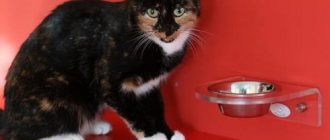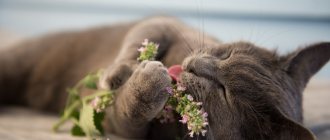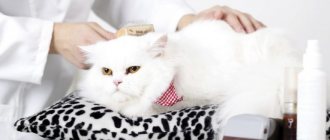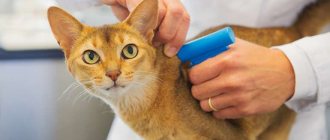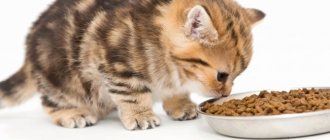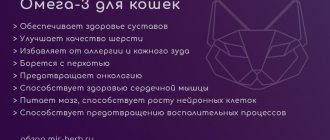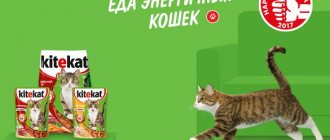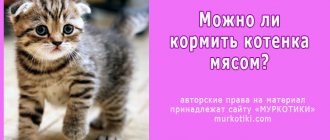What will you learn from the article?
- Why is taurine needed for cats? What does taurine deficiency lead to?
- Symptoms of Taurine Deficiency
- What does an overdose lead to?
- Taurine in natural foods
Taurine is a sulfur-containing amino acid that is present in bile and other tissues of living organisms. Taurine for cats is an essential element, without which the animal cannot live and fully develop. In most mammals, taurine is synthesized in the body; nature has not endowed cats with this ability. Their body vitally needs taurine, but does not know how to “produce” it.
Why nature distributed it this way, what is the importance of taurine for cats, where do they get it in the wild and at home - we will answer these and other questions in this article.
What is taurine and what role does it play in cat food?
Taurine contains an amino group and sulfur - C₂H₇NO₃S.
An acid that contains an amine group and sulfur is necessary for the functioning of the following systems, organs and tissues:
- retina;
- heart muscle;
- fertilization and gestation of the embryo;
- digestion, as it is necessary for the production of bile;
- immune system, which ensures good health and protection against infections.
Prevention measures
The risk of a negative immune system reaction is reduced if the owner adheres to the following rules:
- introducing cat food gradually so that the owner can identify the cause of the allergic reaction;
- use only high-quality meats;
- carefully read the instructions for dry food, which should not contain carcinogenic chemical additives;
- promptly treat various infections, viruses, parasitic diseases;
- eliminating household allergens, such as dust, chemicals, household items;
- To prevent the development of chicken allergies in cats, it is better to feed rabbit or beef.
Allergy is an unpleasant phenomenon that can manifest itself in both a kitten and an adult. It is easier to promptly detect emerging negative manifestations than to treat further disorders. Therefore, there are rules of prevention that allow you to avoid an increased reaction of the animal’s immune system.
What does taurine deficiency cause in cats?
With a deficiency of sulfoamino acid, vision is weakened, especially at night, and heart failure develops. Digestibility of fats decreases, since a lack of taurine does not allow the synthesis of bile in the required volume. Fertility decreases.
Pregnancy pathologies develop. The number of miscarriages increases or weakened kittens are born. Resistance to infectious diseases is falling.
The problem with taurine deficiency is that the disease develops slowly. Pathological symptoms increase gradually over a period of 5 to 24 months. The process can go a long way before signs become noticeable.
Signs of Deficiency
The largest amount of amino acid is required for the muscle tissue of the heart and retina, therefore, if there is a deficiency of the substance in the pet’s body, these organs are the first to suffer.
The breeder should be alert to the following symptoms in the cat:
- drowsiness and lethargy;
- hypothermia (decrease in body temperature below the standard value);
- excessive hair loss;
- destruction of tooth enamel;
- blurred vision;
- dehydration;
- loss of appetite.
Baldness and hair loss are one of the signs of taurine deficiency.
If the problem is not recognized at the initial stage, the consequences can be serious:
- decreased reproductive activity, miscarriages during pregnancy;
- loss of vision;
- various congenital pathologies in kittens.
How much taurine does a cat need?
Studies have found that cats' taurine requirement is 0.1% of food dry matter. The granules contain approximately 90% dry matter. Therefore, the optimal amount of sulfoamino acid in the feed mixture will be 0.1/90*100=0.11%.
Be sure to read:
Proplan or Royal Canin: which food is better for cats, comparison, how to choose the best
However, during heat treatment, proteins are denatured and the absorption of taurine from the intestine into the blood drops sharply. Thus, wet food must include 0.2% taurine on a dry matter basis. If the dry matter content is 25%, you need to add 0.2/25*100=0.8%.
In the production of finished feed, high-temperature drying methods are used, which ensure minimal loss of amino acids.
Ischemia-reperfusion injury
The effects of taurine, such as antioxidant effect, modulation of Ca2+ ions, osmoregulation, regulation of protein phosphorylation and high-energy phosphate, influence the outcome of ischemia-reperfusion injury (IRI). To date, the use of taurine is limited to heart transplantation and coronary artery bypass grafting (CABG). Several studies have shown the benefits of using taurine as a component of cardioplegic solutions or saturating hearts with taurine before using them as donors. In addition to oxidative stress and edema, decreased taurine levels in IRI result in decreased Na+ levels, which reduce osmotic stress and Ca2+ overload [16, 32]. In addition, rapid intravenous infusion of taurine before CABG prevents oxidative stress and cell necrosis [33].
Where is taurine found?
The name "Taurine" comes from the Latin taurus (ox), because it was first isolated from the bile of an ox. Sulfoamino acid is found only in products of animal origin.
The wild ancestors of modern cats did not suffer from taurine deficiency because the amino acid was found in the body of prey. Mice and birds, unlike cats, can synthesize taurine.
Taurine in natural foods
The biologically active substance is contained in meat, and its concentration in dark-colored muscles is several times higher than in light-colored muscles or in offal. However, feeding only meat, and raw meat, not only leads to an excess of proteins, but is also dangerous due to the possible content of microbes and parasites.
Cooking does not destroy taurine, but sharply reduces its absorption. Lack of dietary fiber in food leads to constipation and impaired digestion of food; excess makes it difficult to absorb nutrients.
It is difficult for natural food lovers to calculate the taurine content in food. The tabular data gives average indicators that differ significantly from the real ones. Freezing and defrosting, cooking lead to loss of amino acids. Therefore, there is no need to count how much taurine is contained in the diet.
If a pet walks outside and successfully hunts, it makes up for the amino acid deficiency through prey. When a cat lives on the floor, there are 2 options: switch to ready-made food or purchase powder or tablets. It should be fed according to the instructions without taking into account the taurine content in the products.
Taurine in finished feeds
Amino acid deficiency in ready-made feeds can be solved simply: a feed additive is included in the composition of granules or canned food without taking into account its content in the feed ingredients. The amount of taurine in the manufacture of wet food is doubled to suppress destruction during heat treatment. Manufacturers of the cheapest economy-class feeds, such as Kitekat, report the addition of taurine to the feed mixture.
Be sure to read:
The best cat foods according to veterinarians for 2021
However, among cat lovers there are ardent supporters of feeding cats natural food. The risk of developing taurine deficiency is high. But the veterinary industry produces for them a synthetic analogue of sulfoamino acid in tablets or powder.
Deficient amino acid and why it is needed
Taurine is synthesized in the body of many animals, including dogs. This requires only the presence of methionine and cysteine. Only for cats it turned out to be in short supply. They produce it only in small doses. The reason for this “injustice” is quite simple. The deficient substance is found in huge quantities in the meat of mice and rats. As a result, the body eliminated the useless function during evolution. There was no need to produce Taurine on our own.
shutterstock
But at the same time, the amino acid has always played a key role in the life of the animal.
- Ensures proper functioning of the heart muscle.
- Supports the nervous system and is a powerful cellular antioxidant.
- Affects vision, preventing senile regression.
- Helps synthesize bile acid salts, required for the digestion of fats present in the small intestine.
- Properly supports the immune system.
Taurine must be present in food for a cat bearing offspring. It promotes normal development and fetal formation. The problem of amino acid deficiency in domestic cats was first discovered back in 1950-70. Then mass production of feed began in Europe. Soon, cat breeders began turning to experienced veterinary clinic specialists en masse. Owners of pet dogs noted a noticeable deterioration in their pets’ vision and obvious abnormalities in the functioning of the heart. The unfortunate cats began to look very sad even in appearance.
Research has revealed that a certain amount of Taurine is extremely important for a cat. The substance cannot be replaced, and without it, beloved pets simply “melt” before our eyes. However, at the first stages of production of finished feed, this fact was not taken into account. Today, Taurine is present in them by default. But this applies only to professional food, and not to cheap fakes that resemble inedible sawdust. Such food will not be able to saturate the cat’s body with a sufficient amount of amino acid, which will certainly lead to harmful consequences.
Acid deficiency and consequences
Symptoms of Taurine deficiency in a cat's body are extremely slow. This depends on the age of the pet. In most cases, they progress from 5 months to 2 years before becoming obvious. If the body requires vitamins for cats with Taurine, the symptoms of deficiency are not difficult to determine.
- The retina of the eye gradually begins to degenerate, and vision deteriorates.
- The heart muscle weakens, leading to dilated cardiomyopathy.
- Digestive upset is observed due to the lack of Taurine in bile salts.
shutterstock
It's quite easy to fix the situation quickly. In order for the cat’s body to begin receiving a sufficient amount of Taurine, you just need to switch your beloved pet to professional food. Nutritional supplements may also be required. The main thing is to diagnose Taurine deficiency in a timely manner. Otherwise, retinal atrophy will certainly lead to complete blindness, and dilated cardiomyopathy can even cause the premature death of a pet.
Taurine in cat food: harm or benefit
The benefits of taurine are mentioned above. There have been proposals to use taurine in the diets of some breeds of dogs and humans, and positive results have been obtained. However, all substances heal in small quantities, but become toxic in large quantities. The body responds to a significant increase in the concentration of nutritional components by reducing food consumption.
This is true for almost all substances except taurine. An attempt to establish the toxic dose of taurine failed. And no decrease in feed consumption was observed.
However, harm from an overdose of taurine still exists. Thus, the cost of a package of 60 tablets of the Sevavit feed additive is 600 rubles. A large cat requires 6 tablets per day, the period of use is unlimited. Therefore, the harm to the cat owner’s pocket is quite real.
Vitamin deficiency
If this vitamin is absent from the cat’s body for a long time, a number of negative factors may arise. First of all, vision problems appear. The animal begins to see much worse and is poorly oriented in space. Digestive problems may be noticed. After each meal, as a rule, the gag reflex is actively manifested. Obvious signs are diarrhea or constipation. The most dangerous symptom is heart failure, accompanied by general weakness, drowsiness and malaise.
If such ailments are observed, then you should immediately introduce vitamins with taurine for cats into the diet. A lack of it can lead to the development of serious diseases. In some cases it is a harbinger of death.
Diagnostics
The diagnosis of taurine deficiency can be made by a veterinarian after a physical examination of the cat. Diagnostics may include the following research methods:
- general blood analysis;
- general urine analysis;
- biochemical blood test;
- electroretinogram - examination of the retina of the eye;
- ECG.
If taurine deficiency is suspected, your cat may have an electrocardiogram.
